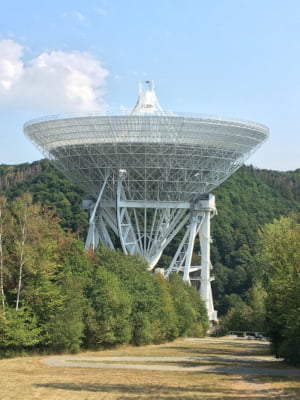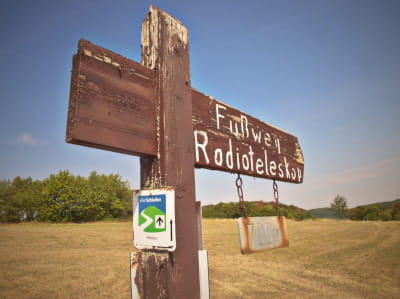Radio Telescope Effelsberg
A visit to an impressive hidden radio telescope in the German Eifel mountains.
We often visit family in Münich, an 8-hour drive from where we live. The German autobahn is world famous and we usually take the trip without major stops. Since is corona year we decided to make a few extra “low tourists” stops on our way back to finally discover a part of Germany we so often crossed but never appreciated. One highlight? Das Radioteleskop Effelsberg.

The telescope is located in the Eifel mountain range in Germany, some 40 km from the Belgian border, and one the largest fully steerable radio telescopes in the world. The dish has a diameter of 100 meters and is 109 meters high but almost invisible from afar since it’s located on the bottom of a valley. The valley shields the antenna from man-made radio interference (so turn off your phone while visiting), the north-south orientation of the valley is important so it can still observe objects in the center of our Milky Way.
In operation since , and continuously improved since, this parabolic reflector radio telescope is still one of the most modern in the world (and the biggest for 28 years untill it was surpassed by the Green Bank one in ). Its job is to observe pulsars, gas- and dust clusters, the sites of star formation, jets of matter emitted by black holes and the distant far-off galaxies as well as radio emission and magnetic fields in our Milky Way and nearby galaxies.
Since the telescope moves the mirror deforms. The support structure is built in such a way it keeps its parabolic shape and the feed antenna suspended in front is moved to keep its focus with an accuracy of less than half a millimetre. That’s a 100-meter movable dish with an accuracy of half a millimetre, wow.
There is a second telescope right next to the main one: the LOFAR Effelsberg station. The LOFAR can observe more extensive wavelengths but looks small and insignificant next to the behemoth dish. Well, maybe it’s larger since it’s part of a European network of 38 such antennas in 7 countries!
There are three astronomy educational walks near the telescope. The Planetenweg, or Planetary Walk, runs from the visitors parking to the telescope and represents a scaled 1:7.7 million version of our solar system: from Pluto to the Sun. Every step you take spans almost 8 million kilometers! I was impressed the kids noticed the distance between the outer planets was greater than the inner ones, a great excuse to talk about distances in space. They also wondered why Pluto was included: “Daddy, you told us Pluto is not a planet, look at this!”. Thanks, astronomers! There is also a Milky Way Walk (Milchstraßenweg) and Galaxy Walk (Galaxienweg) but we didn’t have enough time.
I later learned the Arecibo radio telescope was destroyed by a snapped cable the day we visited the Effelsberg one. No one was hurt but let’s hope they find the funds for reparations.

I must have crossed the region dozens of times, speeding over the autobahn, and never took the time to look around.
What else is hidden behind the mountains?